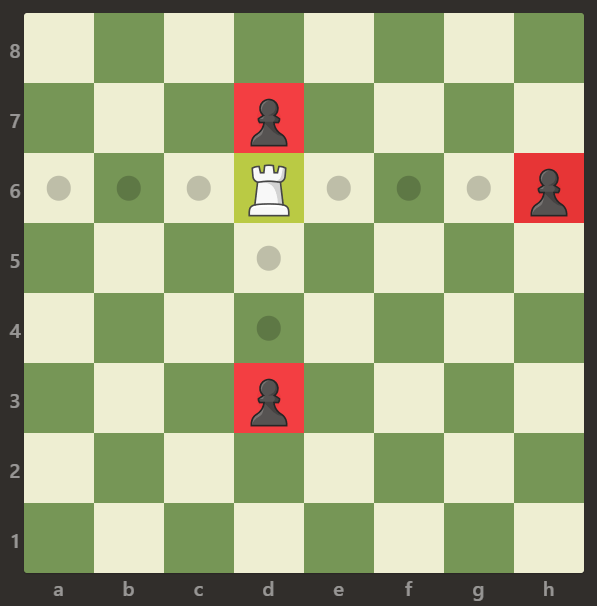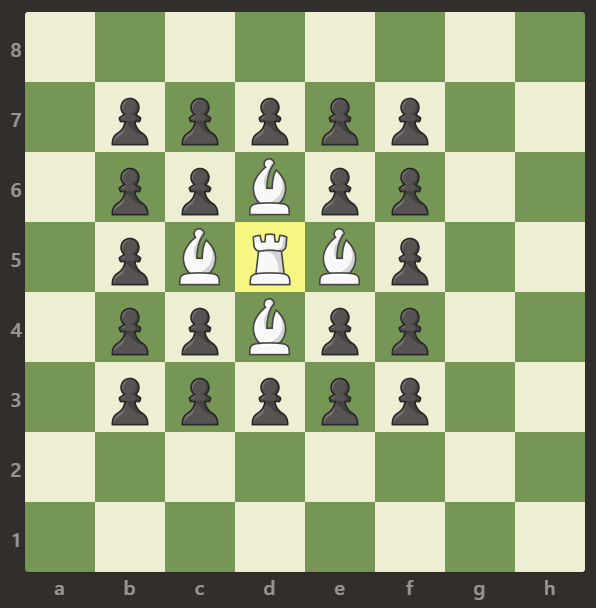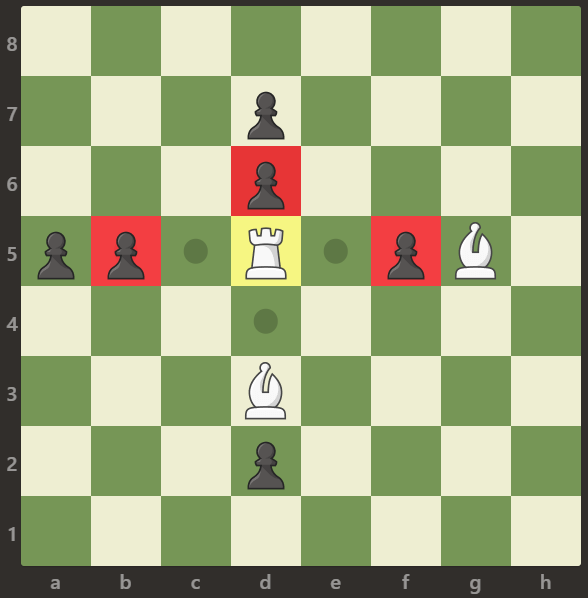Welcome to Subscribe On Youtube
999. Available Captures for Rook
Description
On an 8 x 8 chessboard, there is exactly one white rook 'R' and some number of white bishops 'B', black pawns 'p', and empty squares '.'.
When the rook moves, it chooses one of four cardinal directions (north, east, south, or west), then moves in that direction until it chooses to stop, reaches the edge of the board, captures a black pawn, or is blocked by a white bishop. A rook is considered attacking a pawn if the rook can capture the pawn on the rook's turn. The number of available captures for the white rook is the number of pawns that the rook is attacking.
Return the number of available captures for the white rook.
Example 1:

Input: board = [[".",".",".",".",".",".",".","."],[".",".",".","p",".",".",".","."],[".",".",".","R",".",".",".","p"],[".",".",".",".",".",".",".","."],[".",".",".",".",".",".",".","."],[".",".",".","p",".",".",".","."],[".",".",".",".",".",".",".","."],[".",".",".",".",".",".",".","."]] Output: 3 Explanation: In this example, the rook is attacking all the pawns.
Example 2:

Input: board = [[".",".",".",".",".",".",".","."],[".","p","p","p","p","p",".","."],[".","p","p","B","p","p",".","."],[".","p","B","R","B","p",".","."],[".","p","p","B","p","p",".","."],[".","p","p","p","p","p",".","."],[".",".",".",".",".",".",".","."],[".",".",".",".",".",".",".","."]] Output: 0 Explanation: The bishops are blocking the rook from attacking any of the pawns.
Example 3:

Input: board = [[".",".",".",".",".",".",".","."],[".",".",".","p",".",".",".","."],[".",".",".","p",".",".",".","."],["p","p",".","R",".","p","B","."],[".",".",".",".",".",".",".","."],[".",".",".","B",".",".",".","."],[".",".",".","p",".",".",".","."],[".",".",".",".",".",".",".","."]] Output: 3 Explanation: The rook is attacking the pawns at positions b5, d6, and f5.
Constraints:
board.length == 8board[i].length == 8board[i][j]is either'R','.','B', or'p'- There is exactly one cell with
board[i][j] == 'R'
Solutions
Solution 1: Simulation
First, we traverse the chessboard to find the position of the rook $(x, y)$. Then, starting from $(x, y)$, we traverse in four directions: up, down, left, and right:
- If we encounter a bishop or a boundary, we stop traversing in that direction.
- If we encounter a pawn, we increment the answer by one, and then stop traversing in that direction.
- Otherwise, we continue traversing.
After traversing in all four directions, we can get the answer.
The time complexity is $O(m \times n)$, where $m$ and $n$ are the number of rows and columns of the chessboard, respectively. In this problem, $m = n = 8$. The space complexity is $O(1)$.
-
class Solution { public int numRookCaptures(char[][] board) { int ans = 0; int[] dirs = {-1, 0, 1, 0, -1}; for (int i = 0; i < 8; ++i) { for (int j = 0; j < 8; ++j) { if (board[i][j] == 'R') { for (int k = 0; k < 4; ++k) { int x = i, y = j; int a = dirs[k], b = dirs[k + 1]; while (x + a >= 0 && x + a < 8 && y + b >= 0 && y + b < 8 && board[x + a][y + b] != 'B') { x += a; y += b; if (board[x][y] == 'p') { ++ans; break; } } } } } } return ans; } } -
class Solution { public: int numRookCaptures(vector<vector<char>>& board) { int ans = 0; int dirs[5] = {-1, 0, 1, 0, -1}; for (int i = 0; i < 8; ++i) { for (int j = 0; j < 8; ++j) { if (board[i][j] == 'R') { for (int k = 0; k < 4; ++k) { int x = i, y = j; int a = dirs[k], b = dirs[k + 1]; while (x + a >= 0 && x + a < 8 && y + b >= 0 && y + b < 8 && board[x + a][y + b] != 'B') { x += a; y += b; if (board[x][y] == 'p') { ++ans; break; } } } } } } return ans; } }; -
class Solution: def numRookCaptures(self, board: List[List[str]]) -> int: ans = 0 dirs = (-1, 0, 1, 0, -1) for i in range(8): for j in range(8): if board[i][j] == "R": for a, b in pairwise(dirs): x, y = i, j while 0 <= x + a < 8 and 0 <= y + b < 8: x, y = x + a, y + b if board[x][y] == "p": ans += 1 break if board[x][y] == "B": break return ans -
func numRookCaptures(board [][]byte) (ans int) { dirs := [5]int{-1, 0, 1, 0, -1} for i := 0; i < 8; i++ { for j := 0; j < 8; j++ { if board[i][j] == 'R' { for k := 0; k < 4; k++ { x, y := i, j a, b := dirs[k], dirs[k+1] for x+a >= 0 && x+a < 8 && y+b >= 0 && y+b < 8 && board[x+a][y+b] != 'B' { x, y = x+a, y+b if board[x][y] == 'p' { ans++ break } } } } } } return } -
function numRookCaptures(board: string[][]): number { const dirs = [-1, 0, 1, 0, -1]; const n = board.length; for (let i = 0; i < n; i++) { for (let j = 0; j < n; j++) { if (board[i][j] === 'R') { let ans = 0; for (let k = 0; k < 4; k++) { let [x, y] = [i + dirs[k], j + dirs[k + 1]]; while (x >= 0 && x < n && y >= 0 && y < n && board[x][y] !== 'B') { if (board[x][y] === 'p') { ans++; break; } x += dirs[k]; y += dirs[k + 1]; } } return ans; } } } return 0; } -
impl Solution { pub fn num_rook_captures(board: Vec<Vec<char>>) -> i32 { let dirs = [-1, 0, 1, 0, -1]; let n = board.len(); for i in 0..n { for j in 0..n { if board[i][j] == 'R' { let mut ans = 0; for k in 0..4 { let mut x = i as i32 + dirs[k]; let mut y = j as i32 + dirs[k + 1]; while x >= 0 && x < n as i32 && y >= 0 && y < n as i32 && board[x as usize][y as usize] != 'B' { if board[x as usize][y as usize] == 'p' { ans += 1; break; } x += dirs[k]; y += dirs[k + 1]; } } return ans; } } } 0 } }